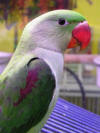. alexandrine parrot

Aviary Notes: Level Of Knowledge Required: Beginner / Intermediate / Advanced / Specialist Breeders Only. Government Regulations & By-Laws: Refer to " Government Laws " web page. Housing Requirements: Best results are obtained with one pair per aviary. Many birds like to bathe. Up to 6 metre long and 1.2 metres wide steel framed aviary is preferable. About 4 metre (13 feet) long aviaries are ideal. Their beaks are powerful so strong wire mesh is essential, 2.5mm (12 gauge) wire is suitable. Small aviaries generally result in the birds breaking tail feathers. Leafy branches can be placed in the aviary for the birds to chew up. This will entertain the birds, help minimize boredom and give the birds some beak exercise. Natural branches can be used for perches. These natural perches will be chewed by the birds and may need to be replaced regularly. The birds will chew any flowers and fruiting bodies on the branches. Diet / Feeding: Alexandrines are easy to feed and they like to have a variety of fruits and vegetables as part of a regular food intake. The Alexandrines food requirements are seed based including canary seed, white millet, oats, and sunflower along with a variety of fruits such as apple and orange and a variety of vegetables such as corn, corn-on-the-cob, carrot and celery. Green foods are essential including seeding grasses, green leafy vegetables and sprouted or soaked seed if available. Pine nuts and peanuts can be offered. The birds may consume insects such as mealworm larvae, pupa and beetles, especially during the breeding season. Insects are a good source of easily digested protein for the adults and the young. Commercial parrot pellets and dry dog food can form part of a balanced food intake. Corn-on-the-cob is a favourite and commonly fed to these birds. Calcium supplies such as cuttlefish, shell grit, crushed oyster shell or calcium blocks should always be available. They love chewing on branches. Nesting: A basic overview only. Dimensions are typical / average and can vary widely, influenced by the owner's preferences and the birds preferences. Parent bird's preferences can also be influenced by the size and type of nest-box / log in which the bird was hatched and reared. If space allows, offering a choice of sizes and types of logs or nest-boxes, and placed in various locations within the aviary, can allow the parent birds to make their own choice. Once a pair has chosen a specific nest-box/log and been successful in it, offer that one to them each breeding season. Try and keep that one for their exclusive use. Once a pair has chosen its log or nest-box, the other ones can generally be removed. If the "spare" boxes are to be removed and moved to another flight, ensure the log / nest-box is cleaned to ensure the receptacle has the minimal contamination of mites, parasites and pathogens.
Alexandrines love to chew timber, including the nest box, so a weld mesh internal ladder is recommended. Some breeders place a protective metal cover around the nest box entrance opening to minimize damage by the birds habit of chewing timber. Timber nest-boxes generally require a climbing structure attached inside the box below the entrance hole. Both logs and nests need an entrance hole/opening about 100 mm (about 4 inches) from the top. Many species of parrots like the entrance hole to be just big enough to squeeze through. More details on parrot nestboxes/logs and a selection of parrot nestbox/log photos can be found on the "nests", "parrot nests" and "parrot nestbox photos" web pages. Click on "Up" then "Nests" then "parrot nests" and "parrot nestbox photos" in the navigation bars. Breeding: Egg Colour White. Clutch/s per year = usually one. Eggs per nest 2 - 4. Incubation approx 23 - 27 days. Fledge approx 7 - 8 weeks. Independent approx. another 4 - 5 weeks. Pair bonding is not strong outside the breeding season, the hen is the dominant bird and for new pairs the cock and hen should be introduced several months prior to the anticipated breeding date. Artificial incubation of the first clutch of eggs and the hand-raising of the young can result in an additional clutch of young being produced. The hen will often lay another clutch of eggs if the first clutch is removed. As most pairs only have one clutch per season, it is generally safe to leave the young in the same aviary as the parents after they become independent. If the parent birds want to try for a second clutch they may not want the youngsters in the same aviary. If aggression from a parent bird occurs, the young must be immediately removed to another aviary. Purity of the Alexandrine has been compromised by people crossing these birds with the Ringnecked Parrots to produce colour mutations. Further crosses with species such as the Indian ringneck to produce additional colour variations may further reduce the purity of the Alexandrine gene pool. i.e. hybrid physical characteristics. Most Alexandrine Parrots will allow nest inspections and allow the young to be leg rung. Placing of a closed metal leg ring on the young is essential for the accurate recording of the genetic background of each bird. Special care should be taken to ensure adequate food is available while young are in the nest. Generally Alexandrine's are excellent parents. Hand reared or young taken straight from the nest become very tame and may learn to talk. When in good health, Alexandrine parrots always present well with perfect feather condition. Artificial incubation and hand rearing or fostering will not be covered on this web site. It is too complex and diverse in nature to be attempted here. Health Issues: Refer to "Avian Health Issues" web page for information and references.
General References: Refer to references listed on "Book References" web page. Specific References:
|